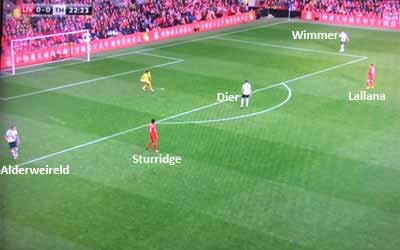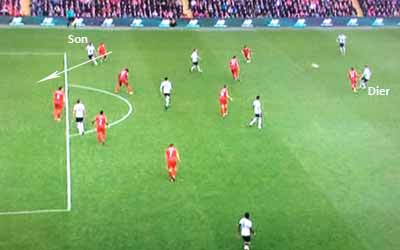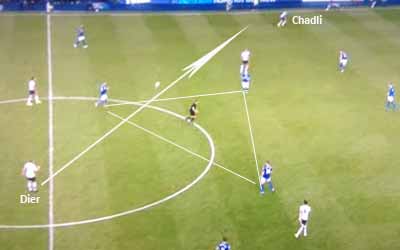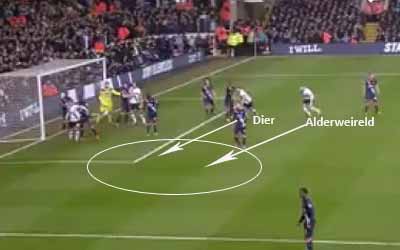Eric Dier has been a revelation for Spurs this season, but he offers far more to the defensive midfielder role than just tough tackling.
Eric Dier has been the surprise of the season. His rapid growth in to one of the best defensive midfielders in the Premier League is astonishing. Not from the perspective of his ever-improving talent level, but by just how quickly he settled in to and blossomed in the role.
Dier defence
Being a defensive midfielder, Eric Dier’s primary function is to protect his back four, sniff out danger and shut it down. He has done this tremendously well and its one of the reasons why we conceded the equal fewest goals in the Premier League this season.
His size and evolution as a centre back has meant that he is a natural for Mauricio Pochettino’s system. The holding midfielder has to not only be good at tackling, but also has to read the game to intercept passes and recover loose balls. His size and leaping ability is used to win headers, both at the back and in the opposition’s box at corners. Paramount to the role in the defensive phase is that he often has to drop in to the back line to support and aid the centre backs and here he feels comfortable and at home.
Dier distribution
Eric Dier often has to move in-between the split central defenders to make a back three to bring the ball out. It is in this distribution phase that he has equally excelled and one that is highly important for the team. Having a player that can pass well from these areas gets our attacks moving more readily. It also transitions the ball quickly to the attacking players before the opposition’s defence can get set.

Eric Dier dropping between our centre backs has become so normal that we just expect it. However, it is his ability on the ball makes him a very valuable commodity in this position.
His distribution is the most underrated and often under-talked about part of his game. Often overshadowed by the pinpoint accuracy of Toby Alderweireld behind him, Dier also has the penchant for picking a pass.
On the ball Dier’s role is threefold. Firstly, he is tasked with circulating it between the keeper and the centre backs in order to navigate any opposition press.
Once this is done, his second task is to move the ball up a level in the attack. This can be as simple as getting it forward in to the advanced midfield trio or directly up to Harry Kane when he comes short.
His third task, and one that he doesn’t get enough credit for, is to hit longer passes to alter the angle of the attack. This can be as we saw against Liverpool to find Son’s out-to-in run.

It can also be as we see here against Everton to hit Nacer Chadli on the move. This pass navigates Everton’s central midfield trio, taking them out of the game.

His passing map from that Everton game highlights just how often he plays these switches or can go directly towards the box.

There is a really nice video by Jake Manton (@Yedlin on Twitter) that focuses on Eric Dier in the Everton game. It shows really well how he operates in the defensive phase to sniff out and shut down their attacks, but also just how good his distribution forward and in to the final third is.
It also shows one final element that is an important tactical part of what Pochettino wants from Eric Dier.
Eric Dier the containment valve
Eric Dier has phenomenal strength and stamina, but he also possesses extremely good speed through his long strides. These elements see Mauricio Pochettino use him as much more than a conventional defensive midfielder.
Our manager has adjusted his position so that he moves up the pitch as play progresses to hem the opposition in, acting almost as a containment valve. This is because Pochettino trusts that he has the speed and stamina to recover should we lose the ball and the opposition gets out past our initial press.
His goal against Manchester City in our 4-1 win highlighted just this. He swept in behind our initial attack to hoover up Kevin De Bruyne’s errant pass out and lash it back in to the goal with interest.
What having Dier move in this way also does allows him to play the ball from much higher positions up the pitch when we win it back. Rather than just use him to pass the ball out from in-between our split centre backs and then assume his job is done, Dier then has to move up the pitch as the ball goes further forward. This sees him get possession and become much more of a factor up the field, as he can use his distribution skills. Whether this is passing out to the sides of the formation to keep possession flowing or looking to play a more aggressive vertical pass, it gives Eric Dier a much fuller role in the system than just being a ball winner.
Eric Dier deadly at corners
Effectively having the size and aerial power of a third centre back on the field means that we have additional strength at set pieces. Spurs led the Premier League in set piece goals this season, an area of the game that Mauricio Pochettino works hard at in his coaching sessions.
What we often see is a routine from the team that involves us leaving the front corner of the six-yard box free. Eric Dier and Toby Alderweireld then race towards this vacant area looking for a header as the corner is swung in.
It’s designed to catch the opposition off guard in a high-percentage scoring area. We’ve had tremendous success with this routine with both Alderweireld and Dier getting goals from it in the Premier League and Europa League.
Dier’s goal in the Spurs 2-2 Stoke game saw him open the scoring by being first to the vacant zone to meet Eriksen’s delivery.

Watch his goal at home to Newcastle and this was also from the same routine. This time there is the nice addition of Tom Carroll moving off the goal line to screen the Newcastle defender from getting to the ball.

Eric Dier: defence and distribution
Eric Dier has been a revelation in the defensive midfielder role this season. He is excellent at breaking up play, but being so comfortable on the ball and in his distribution, it will make finding an apt back up or rotation option for him difficult to find this summer.

Excellent analysis, Mark. In a team of players who upped their levels this season, for me, he stood out. For all the reasons you mention. He’s also two-footed, and having been brought up on the Continent, you can see like our other continentals, he has superior technical ability. One other factor not mentioned. He’s what, 22, and gone from part time FB/CB to starting CM to probably England kingpin (all inspired by MoPo’s encouragement and tactical nous). He also has leadership abilities, it’s obvious, a future captain. In many ways, we could do with an outfield captain, not Hugo (as positive an example he is) at the back, someone in the maelstrom of activity. I don’t know how MoPo can swing it, but I’d make him a co-captain or even captain, right away. I truly like him as a player and person, and even the way he was throwing himself about in Cheatski game – he’s got cajones and true Tottenham grit like Mackay, Roberts, etc. Cheers Mark!
Great point about his two-footedness and technical ability Ashley. I believe he will be a good captain one day. Pochettino names the captain and two vice captains in preseason. Currently its Hugo wth JV and Kane as vice-captains. I can’t see any of them being demoted just yet. Being captain prob keeps Hugo at the club. Vertonghen would def be in a strop if he was demoted and Harry is a future captain too. Can’t see MoPo upsetting the apple cart at the minute.
Hi Mark,
Thanks for the great read. Been an avid reader for a couple of years now and it’s great to understand the tactical side of the game better. I was wondering if you could do a piece on Roy hodgson’s tactics with England given how many spurs players likely to start now?
Seems to me he is doing a variant of Poch’s.
And if you have time an analysis of where the execution of Spurs tactics could be improved by new playing personnel and who might fit the bill would also be awesome.
Hi Pete, thanks for reading and the great ideas for posts. I plan to cover England’s games at the Euros and do some stuff on Roy’s tactics, so more on that will be coming up nearer the tournament. A piece on where we can improve the execution of tactics and who might fit the bill is an interesting one, probably best answered when the transfer window opens on July 1st. So, stay tuned!
Thanks Mark, looking forward to reading them.